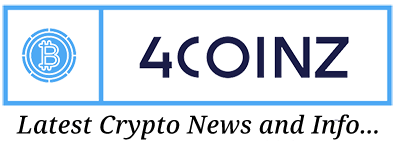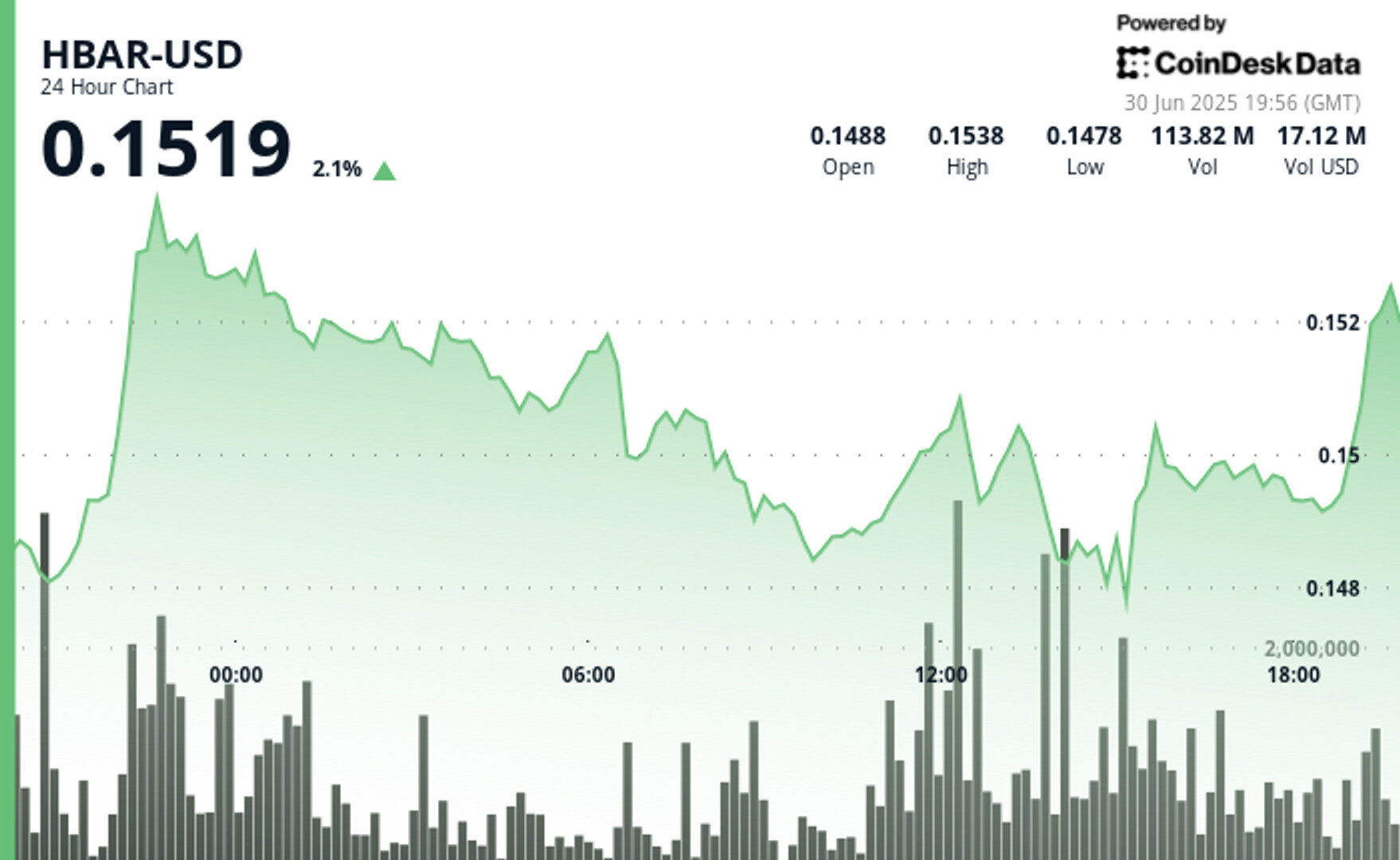BTC
$107,608.53
+
0.05%
ETH
$2,503.66
+
2.99%
USDT
$1.0003
+
0.01%
XRP
$2.2932
+
4.76%
BNB
$659.10
+
1.57%
SOL
$156.59
+
3.31%
USDC
$1.0001
+
0.02%
TRX
$0.2797
+
1.51%
DOGE
$0.1669
+
1.51%
ADA
$0.5846
+
4.22%
HYPE
$40.82
+
6.01%
BCH
$514.52
+
4.44%
WBT
$44.32
–
5.07%
SUI
$2.8017
–
0.33%
LINK
$13.57
+
1.29%
LEO
$9.1073
+
0.93%
AVAX
$18.10
–
0.33%
XLM
$0.2403
+
1.62%
SHIB
$0.0₄1153
–
0.50%
LTC
$86.51
–
0.34%
By Siamak Masnavi, CD Analytics|Edited by Aoyon Ashraf
Jun 30, 2025, 8:21 p.m.

- HBAR rose 2.1% to $0.1519 over the past 24 hours, reaching an intraday high of $0.154.
- Technical action showed a 4.2% trading range with support at $0.148 and resistance near $0.150.
- Hedera’s June updates include new council members, AI development tools, and Web3 gaming partnerships.
Hedera’s native token HBAR
extended its rally on Sunday, trading up 2.1% to $0.1519 as of 19:56 UTC on June 30, according to CoinDesk Research’s technical analysis model.
The move follows a flurry of ecosystem updates that broaden Hedera’s enterprise reach and reinforce its growing footprint in AI, gaming, and sustainability.
STORY CONTINUES BELOW
On June 24, Blockchain for Energy (B4E), a nonprofit focused on sustainability data management in the energy sector, officially joined the Hedera Governing Council. B4E already runs its carbon tracking platform on the Hedera network, and its addition brings domain expertise in emissions reporting and digital MRV (measurement, reporting, and verification) standards. As a council member, B4E will run its own node and contribute to governance decisions—particularly those aligned with environmental transparency and enterprise accountability.
Just two days later, Hedera unveiled its AI Studio, an open-source software development kit designed to help developers build decentralized applications powered by artificial intelligence. The suite includes an Agent Kit that integrates with LangChain and enables AI agents to interact directly with Hedera’s consensus and token services using natural language commands. The goal is to lower the barrier for AI-native apps while maintaining onchain auditability, transparency, and regulatory alignment.
On the gaming front, Hedera Foundation announced on June 19 a partnership with The Binary Holdings (TBH), a Web3 infrastructure firm. The collaboration aims to bring Hedera-based gaming apps to mobile users in Southeast Asia via OneWave, TBH’s decentralized app store. Integrated into native telecom platforms across Indonesia and the Philippines, OneWave is expected to onboard over 169 million users with built-in Web3 rewards and onchain verification.
Meanwhile, in mid-June, the U.S. Securities and Exchange Commission began a formal review of the Canary HBAR ETF, which would offer direct exposure to HBAR via a regulated investment vehicle. A public comment period is now open ahead of the SEC’s July 7 deadline. If approved, the ETF could catalyze broader institutional access and further legitimize HBAR’s role in capital markets—though regulatory scrutiny remains high, and analysts remain divided on long-term token utility.
Technical Analysis Highlights
- HBAR traded in a 4.1% range from $0.1478 to $0.1538 between June 29 19:00 UTC and June 30 18:59 UTC.
- A strong breakout occurred during the 22:00 hour on June 29, with price surging to $0.154 on volume of 104.5M units.
- Major support formed at $0.148 between 14:00–15:00 UTC on June 30, with 80.6M units traded.
- From 18:00–18:59 UTC on June 30, HBAR showed a V-shaped recovery, dipping to $0.149 before rebounding.
- During the 18:20–18:21 UTC window on June 30, price stabilized with 1.3M in volume, forming short-term support at $0.149.
- As of 19:56 UTC on June 30, HBAR traded at $0.1519, up 2.1% for the day with resistance seen at $0.1538.
Disclaimer: Parts of this article were generated with the assistance from AI tools and reviewed by our editorial team to ensure accuracy and adherence to our standards. For more information, see CoinDesk’s full AI Policy.
Siamak Masnavi is a researcher specializing in blockchain technology, cryptocurrency regulations, and macroeconomic trends shaping the crypto market. He holds a PhD in computer science from the University of London and began his career in software development, including four years in the banking industry in the City of London and Zurich. In April 2018, Siamak transitioned to writing about cryptocurrency news, focusing on journalism until January 2025, when he shifted exclusively to research on the aforementioned topics.
CoinDesk Analytics is CoinDesk’s AI-powered tool that, with the help of human reporters, generates market data analysis, price movement reports, and financial content focused on cryptocurrency and blockchain markets.
All content produced by CoinDesk Analytics is undergoes human editing by CoinDesk’s editorial team before publication. The tool synthesizes market data and information from CoinDesk Data and other sources to create timely market reports, with all external sources clearly attributed within each article.
CoinDesk Analytics operates under CoinDesk’s AI content guidelines, which prioritize accuracy, transparency, and editorial oversight. Learn more about CoinDesk’s approach to AI-generated content in our AI policy.
















